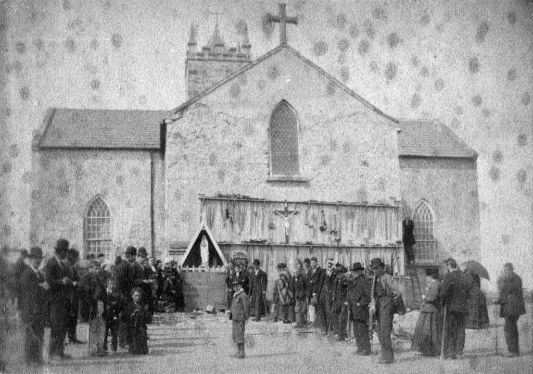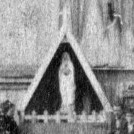Statues used at Knock for "apparition"?
On the night of the 21st of August 1879 the Virgin Mary flanked by St Joseph and
a bishop thought to be St John the Evangelist and an altar with a lamb and cross
on it allegedly appeared on the gable wall of the Parish Church for a few hours.
Fifteen people witnessed the vision including a child of five (page 60, The
Evidence for Visions of the Virgin Mary).
The people saw white images. The witnesses referred to them as statues. Nobody
saw them coming or going. The witnesses claimed that they all left the vision
and that when they came back to the spot, there was nothing to be seen there
only the rain battering against the gable.
The witnesses left depositions. We know there would be at least small errors or
exaggerations in the depositions. Imagination played a role and always does. The
Church recognises this and says that even if an apparition is real and
believable that does not mean that everything said by the witness is necessarily
true. But the accounts all agree that the vision was of statues. There is
disagreement on whether a cross or lamb statue was there or not.
Most of the testimonies state that the images were statues. They could say that
if the image was a picture of statues. Or if they were real statues. The Church
says this means the visionaries just thought they were statues as they were so
statuelike but that does not mean they were statues or images of statues. But
the testimonies are clear: the images were of statues not people. It is accepted
that all the visionaries came to agree that the figures never moved (page 185,
197, 211, Knock The Virgin's Apparition in the Nineteenth Century).
Why couldn't they be actual statues for nobody seen them coming and nobody seen
them going?
One of the first witnesses was Mrs Flatley who was walking by the church. Mrs
Flatley's testimony says she saw the three figures and thought they were statues
the priest left outside. She paid no attention and walked on by.
All of the witnesses said the figures showed no sign of life. There was an
exception. Unreliable Mary McLoughlin said they moved but movement is a very
easy thing to imagine. But she never put that into her deposition so it is mere
gossip. None of the official depositions speak of the images being alive.
Patrick Hill said the images moved but he was not referring to them moving as if
they were alive. The tableau as a whole appeared to or seemed moved in and out a
bit. He said, "at times she [the Virgin] appeared, and all the figures appeared
to move out and again to go backwards ; I saw them move ; she did not speak."
This moving may have been an optical illusion. Did McLoughlin then mistake this
moving for the images moving as if they were alive?
She had seen the images on the way to Beirne's house. Later she and Mary Beirne
passed the gable and the former exclaimed they are not statues they are moving.
She was excited and at a distance from the Church. It is easy to imagine statues
moving at a distance and especially if there is a light shining on them.
Bridget Trench said they didn’t move (page 29, The Apparition at Knock) and Mary
Beirne said they showed no signs of life (page 48, The Apparition at Knock).

The above picture from early 1880, the year after the "apparition" is
interesting. It was taken within a year of it because Miss Mc Kee from Dublin
presented a statue of Mary as depicted in the apparition later on that year
apparently in the Autumn.
For all you know, the statue you see in the image could have been the actual apparition statue. From the way the witnesses stood at a distance it would seem that the images were not lifesize though they could be seen as bigger from a distance. Even what you see below bears a complete resemblance to what the witnesses said about the Virgin Mary. The only difference is that there is no crown on the head.

Notice the size of the window sill - big enough to put a light source on to
shine down to create a mystical looking glow! Some exaggerated the brightness.
But Mary Beirne said in 1932 that the light was like the soft silvery light of
the moon (page 50, The Apparition at Knock).
Patrick Beirne made the following declaration before a priestly board of
investigators of the apparition in 1932."I saw three figures on the gable
surrounded by wonderful light. They appeared to be something like shadows or
reflections cast on a wall on a moon-lit night. I approached nearer the gable
and passed my hand along the wall to find there was no material substance there.
The figures were towards the left hand side of the gable. The figures were those
of the Blessed Virgin in the central position; to the right of the Blessed
Virgin was St Joseph, and to the left was a figure suggested by a bystander to
represent St John the Evangelist. To the right of the group, and at a higher
level was a figure of a lamb in a reclining position and facing the figures. I
spent between twenty minutes and a half an hour there when I returned home."
He didn't say he touched the wall until decades later. He speaks of the images
being like shadows. The light was dull. If his memory is right then maybe it was
a picture of statues that he saw and not actual statues.
The low light would mean that crude statues could look very impressive. If a
statue of Lourdes was used for Mary Lourdes iconography such as the rosary beads
and the flowers on the feet would not have been noticed. Nobody mentioned seeing
those features. Lourdes statues have a veil but none is mentioned for the Knock
Virgin and it could have been mistaken for her hair. And with the crown it might
not have been easy to tell.
The exact spot where the Virgin stood at an apparition site is extremely
important to Catholics. It seems safe to assume that as the witnesses of the
apparition would have been consulted the statue of Mary does indeed mark the
spot though it seems to be higher up than the Virgin would have been. But you
can be sure it is positioned over the spot.
The statue is of our Lady of Lourdes. It has not been noted how similar the
Knock virgins pose was to statues of Our Lady of Lourdes. Both are depicted as
looking up to heaven and praying with hands held up to the chest. The difference
is that the Knock vision didn't have the hands touching and Lourdes does. But
there are statues of Our Lady of Lourdes with hands touching at the fingers and
otherwise apart which is nearly the same pose as the Knock apparition. And how
the Virgin positioned her hands is a minor detail - what if she in fact did not
hold them apart?
From a distance it would be hard to see if they were apart or not.
The statue depicted is a fair size and would pass for life size if it were not
for the people standing beside it if you are standing where the photographer
stood.
The picture below shows where the witnesses stood.

Remember the witnesses stood at a further distance away though a couple went
close briefly and observed that the entities were statues. They also looked at
the tableau at an angle.
Judith Campbell spoke of "the place in which the figures [ORIGINAL SAYS statues]
appeared".
Margaret Beirne says, "I saw an altar there ; it was surrounded with a bright
light ... and so too were the other figures [statues in the original manuscript
- ORIGINAL "AS WELL AS ALL THE STATUES"], which were similarly surrounded."
The Church tells us that Bridget Trench that she tried to touch the Virgin’s
feet but there was nothing there. However she never made such a claim. Was it
made up in case the public would realise somebody stuck statues at the gable?
And why did the witnesses think the bishop was John? Because Mary Beirne noticed
how the image resembled the statue of St John she saw in Lecanvey near Westport.
She was the one who decided it was John. The third figure appeared to be that of
St, John the Evangelist ; I do not know, only thought so, except the fact that
at one time I saw a statue at the chapel of Lekanvey, near Westport, County
Mayo, very much resembling the figure which stood now before me in group. The
priest Cavanagh, who many think was in on the hoax, would have been familiar
with the statue for he ministered for years in Westport. And Mary Beirne was a
friend of his...
Margaret Beirne was certain of the statue. In her deposition, the following is
squeezed in around her signature as if the priest didn't want to put it in. It
was obviously important to her that he put it in. "The reason I knew it was St
John was because I saw a statue of him at Lecanvey chapel."
Dominick Beirne declared, "The reason I had for calling the third figure St.
John is because some saw his statue or his likeness at Lekanvey parish chapel."
Despite the evidence, it is insisted by the Church that the statue of John never
existed. Why the lie?
Could it be that the statue did exist and vanished in 1879 and was used in the
"apparition"?
Archbishop Murphy of Tasmania asked pilgrims to pray that the figures of Mary
had not been an image of her but really her (page 197, Knock The Virgin's
Apparition in the Nineteenth Century). This shows that the general consensus was
that the Virgin and the others had not personally come to Knock and what was
seen was an art form in their honour. The consensus was taken seriously enough
by Archbishop Murphy that he had to get prayers said in the hope of evidence
that the consensus was wrong.
To me, the fact that the vision was not really a visitation by heavenly beings
is sufficient proof that it was the waste of a miracle and has led most
believers in the vision astray for they think it was a visitation. The miracle
was not from God for it caused error. Protestants might say that the absurdities
of the vision would show that it was Satan at work.
Could it be that somebody put statues at the gable? Did they paint the statues
all white? Did somebody put a crown on a statue of Our Lady of Lourdes and plot
it at the gable with a light shining on it which would have made it look more
mystical? It is possible that a statue of Mary and St Patrick (mistaken for St
John) was used. A witness however stated that the St John image resembled a
statue of St John at Lecanvey. And why does St Joseph have the same pose as he
has in life-size cribs? Some elements had to be altered in order to avoid the
statues used being identified so you would expect a reasonable match not an
exact one.
Conclusion
Statues and a light source may explain what happened at Knock. One way or
another we are talking about statues or images of statues.
BOOKS CONSULTED
The Apparition at Knock, The Ecumenical Dimension, Eoin de Bháldriathe, Data
Print, Athy, 2013
Margaret Anna Cusack, The Nun of Kenmare, by Catherine Ferguson CSJP, Gaelbooks,
Co Down, 2008
Knock The Virgin's Apparition in Nineteenth Century Ireland, Eugene Hynes, Cork
University Press, Cork, 2008
Knock: Some New Evidence. The British and Irish Skeptic, Berman, David. Vol 1,
no. 6, November/December 1987
Knock 1879-1979, Rynne, Catherine. Dublin: Veritas Publications, 1979
Looking for a Miracle, Joe Nickell, Prometheus Books, New York, 1993
Our Lady of Knock, John MacPhilpin, Tom Neary, London: Catholic Truth Society,
1976
Our Lady of Knock. William D Coyne, New York: Catholic Book Publishing, 1948
"Papal Visit Resurrects Ireland's Knock Legend." The Freethinker (October 1979).
Reprinted in The British and Irish Skeptic 1, no. 1 January/February 1987
The Apparition at Knock, A Survey of Facts and Evidence, Fr Michael Walsh, St
Jarlath’s College, Tuam, Co Galway, 1959
The Apparitions and Miracles at Knock, also Official Depositions of the
Eye-Witnesses. Tuam, Ireland, 1880. 2d ed. Dublin: M. H. Gill & Son, 1894.
Mother of Nations, Joan Ashton, Veritas, Dublin, 1988
The Book of Miracles, Stuart Gordon, Headline, London, 1996
The Cult of the Virgin Mary, Michael P Carroll, Princeton University Press, 1986
The Evidence for Visions of the Virgin Mary, Kevin McClure Aquarian Press,
Wellingborough, Northamptonshire, 1985
The Thunder of Justice, Ted and Maureen Flynn, MAXCOL, Vancouver, 1993
The Wonder of Guadalupe, Francis Johnson, Augustine, Devon, 1981
Why Statues Weep, Editors Wendy M Grossman and Christopher C French, The
Philosophy Press, London, 2010
Venerable Archdeacon Cavanagh, Liam Úa Cadhain, Knock Shrine Society, Roscommon
Herald, Boyle, Roscommon, Ireland, 2004





